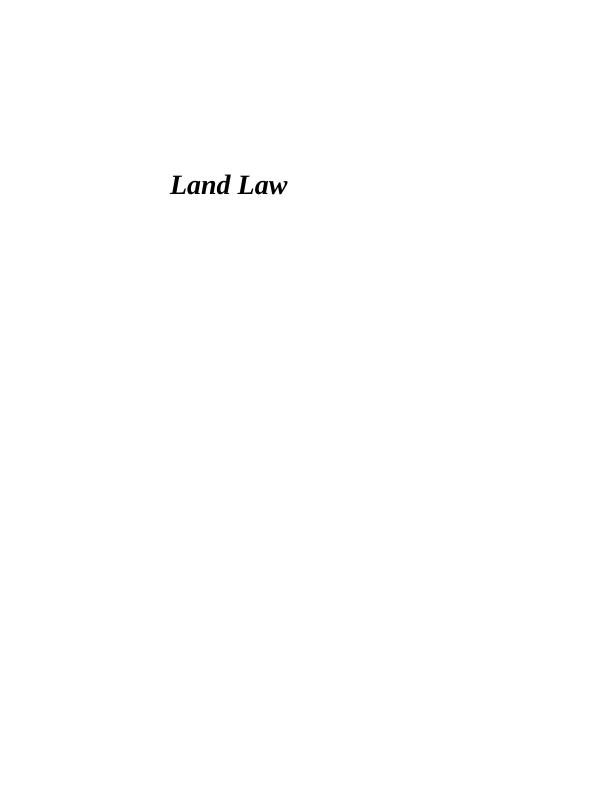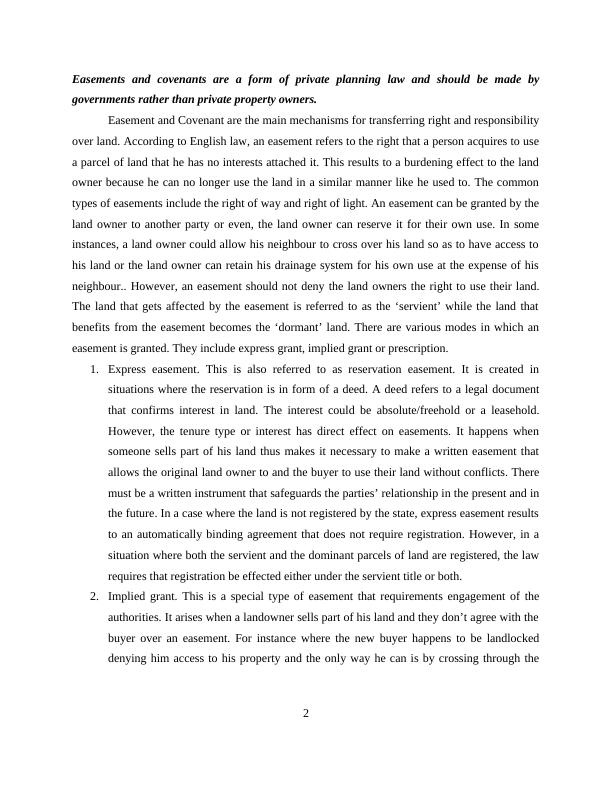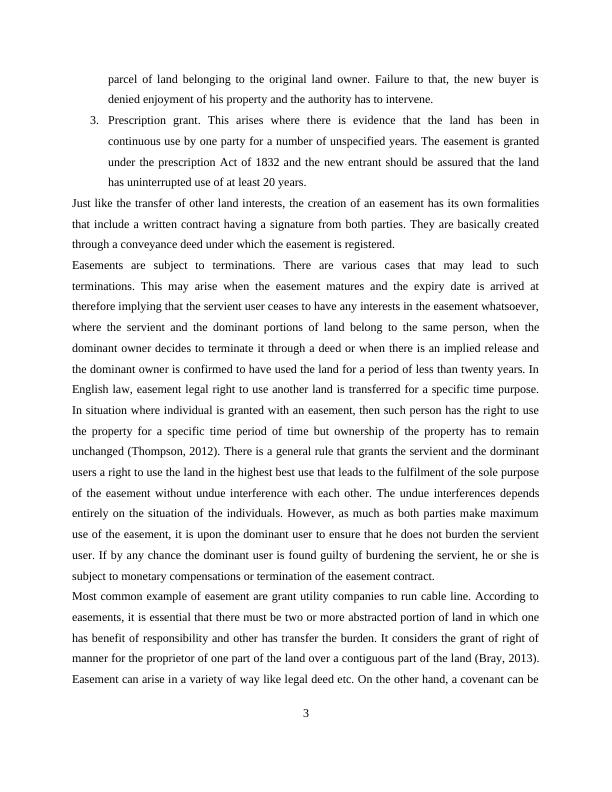Easements and Covenants in Land Law
Added on 2023-04-21
11 Pages4007 Words362 Views
Land Law

Easements and covenants are a form of private planning law and should be made by
governments rather than private property owners.
Easement and Covenant are the main mechanisms for transferring right and responsibility
over land. According to English law, an easement refers to the right that a person acquires to use
a parcel of land that he has no interests attached it. This results to a burdening effect to the land
owner because he can no longer use the land in a similar manner like he used to. The common
types of easements include the right of way and right of light. An easement can be granted by the
land owner to another party or even, the land owner can reserve it for their own use. In some
instances, a land owner could allow his neighbour to cross over his land so as to have access to
his land or the land owner can retain his drainage system for his own use at the expense of his
neighbour.. However, an easement should not deny the land owners the right to use their land.
The land that gets affected by the easement is referred to as the ‘servient’ while the land that
benefits from the easement becomes the ‘dormant’ land. There are various modes in which an
easement is granted. They include express grant, implied grant or prescription.
1. Express easement. This is also referred to as reservation easement. It is created in
situations where the reservation is in form of a deed. A deed refers to a legal document
that confirms interest in land. The interest could be absolute/freehold or a leasehold.
However, the tenure type or interest has direct effect on easements. It happens when
someone sells part of his land thus makes it necessary to make a written easement that
allows the original land owner to and the buyer to use their land without conflicts. There
must be a written instrument that safeguards the parties’ relationship in the present and in
the future. In a case where the land is not registered by the state, express easement results
to an automatically binding agreement that does not require registration. However, in a
situation where both the servient and the dominant parcels of land are registered, the law
requires that registration be effected either under the servient title or both.
2. Implied grant. This is a special type of easement that requirements engagement of the
authorities. It arises when a landowner sells part of his land and they don’t agree with the
buyer over an easement. For instance where the new buyer happens to be landlocked
denying him access to his property and the only way he can is by crossing through the
2
governments rather than private property owners.
Easement and Covenant are the main mechanisms for transferring right and responsibility
over land. According to English law, an easement refers to the right that a person acquires to use
a parcel of land that he has no interests attached it. This results to a burdening effect to the land
owner because he can no longer use the land in a similar manner like he used to. The common
types of easements include the right of way and right of light. An easement can be granted by the
land owner to another party or even, the land owner can reserve it for their own use. In some
instances, a land owner could allow his neighbour to cross over his land so as to have access to
his land or the land owner can retain his drainage system for his own use at the expense of his
neighbour.. However, an easement should not deny the land owners the right to use their land.
The land that gets affected by the easement is referred to as the ‘servient’ while the land that
benefits from the easement becomes the ‘dormant’ land. There are various modes in which an
easement is granted. They include express grant, implied grant or prescription.
1. Express easement. This is also referred to as reservation easement. It is created in
situations where the reservation is in form of a deed. A deed refers to a legal document
that confirms interest in land. The interest could be absolute/freehold or a leasehold.
However, the tenure type or interest has direct effect on easements. It happens when
someone sells part of his land thus makes it necessary to make a written easement that
allows the original land owner to and the buyer to use their land without conflicts. There
must be a written instrument that safeguards the parties’ relationship in the present and in
the future. In a case where the land is not registered by the state, express easement results
to an automatically binding agreement that does not require registration. However, in a
situation where both the servient and the dominant parcels of land are registered, the law
requires that registration be effected either under the servient title or both.
2. Implied grant. This is a special type of easement that requirements engagement of the
authorities. It arises when a landowner sells part of his land and they don’t agree with the
buyer over an easement. For instance where the new buyer happens to be landlocked
denying him access to his property and the only way he can is by crossing through the
2

parcel of land belonging to the original land owner. Failure to that, the new buyer is
denied enjoyment of his property and the authority has to intervene.
3. Prescription grant. This arises where there is evidence that the land has been in
continuous use by one party for a number of unspecified years. The easement is granted
under the prescription Act of 1832 and the new entrant should be assured that the land
has uninterrupted use of at least 20 years.
Just like the transfer of other land interests, the creation of an easement has its own formalities
that include a written contract having a signature from both parties. They are basically created
through a conveyance deed under which the easement is registered.
Easements are subject to terminations. There are various cases that may lead to such
terminations. This may arise when the easement matures and the expiry date is arrived at
therefore implying that the servient user ceases to have any interests in the easement whatsoever,
where the servient and the dominant portions of land belong to the same person, when the
dominant owner decides to terminate it through a deed or when there is an implied release and
the dominant owner is confirmed to have used the land for a period of less than twenty years. In
English law, easement legal right to use another land is transferred for a specific time purpose.
In situation where individual is granted with an easement, then such person has the right to use
the property for a specific time period of time but ownership of the property has to remain
unchanged (Thompson, 2012). There is a general rule that grants the servient and the dorminant
users a right to use the land in the highest best use that leads to the fulfilment of the sole purpose
of the easement without undue interference with each other. The undue interferences depends
entirely on the situation of the individuals. However, as much as both parties make maximum
use of the easement, it is upon the dominant user to ensure that he does not burden the servient
user. If by any chance the dominant user is found guilty of burdening the servient, he or she is
subject to monetary compensations or termination of the easement contract.
Most common example of easement are grant utility companies to run cable line. According to
easements, it is essential that there must be two or more abstracted portion of land in which one
has benefit of responsibility and other has transfer the burden. It considers the grant of right of
manner for the proprietor of one part of the land over a contiguous part of the land (Bray, 2013).
Easement can arise in a variety of way like legal deed etc. On the other hand, a covenant can be
3
denied enjoyment of his property and the authority has to intervene.
3. Prescription grant. This arises where there is evidence that the land has been in
continuous use by one party for a number of unspecified years. The easement is granted
under the prescription Act of 1832 and the new entrant should be assured that the land
has uninterrupted use of at least 20 years.
Just like the transfer of other land interests, the creation of an easement has its own formalities
that include a written contract having a signature from both parties. They are basically created
through a conveyance deed under which the easement is registered.
Easements are subject to terminations. There are various cases that may lead to such
terminations. This may arise when the easement matures and the expiry date is arrived at
therefore implying that the servient user ceases to have any interests in the easement whatsoever,
where the servient and the dominant portions of land belong to the same person, when the
dominant owner decides to terminate it through a deed or when there is an implied release and
the dominant owner is confirmed to have used the land for a period of less than twenty years. In
English law, easement legal right to use another land is transferred for a specific time purpose.
In situation where individual is granted with an easement, then such person has the right to use
the property for a specific time period of time but ownership of the property has to remain
unchanged (Thompson, 2012). There is a general rule that grants the servient and the dorminant
users a right to use the land in the highest best use that leads to the fulfilment of the sole purpose
of the easement without undue interference with each other. The undue interferences depends
entirely on the situation of the individuals. However, as much as both parties make maximum
use of the easement, it is upon the dominant user to ensure that he does not burden the servient
user. If by any chance the dominant user is found guilty of burdening the servient, he or she is
subject to monetary compensations or termination of the easement contract.
Most common example of easement are grant utility companies to run cable line. According to
easements, it is essential that there must be two or more abstracted portion of land in which one
has benefit of responsibility and other has transfer the burden. It considers the grant of right of
manner for the proprietor of one part of the land over a contiguous part of the land (Bray, 2013).
Easement can arise in a variety of way like legal deed etc. On the other hand, a covenant can be
3

defined as a promise formed through express agreement between two or more parties. The
Covenant can either be negative or positive (Making Land Work: Easements, Covenants and
Profits à Prendre, 2011). Negative covenant impose restriction on the usage of land on the
owner while positive covenant impose obligation to do something (for example act of repair and
maintenance). Negative covenants in most cases burden the land owners by denying them direct
use of their property.
According to English land law, the sole purpose of an easement is to give a right to an
individual over some other land for its usage without interfering with original owners of that
land. The most common example of an easement is the right of way which at times extends to as
far as being granted the right to use a neighbour’s land to park a car. In some situation it may be
not possible for one land owner to access a national highway without an easement of a right of
way. Creation of easement is usually done expressly by deed, but it may be implied where it is
essential or would be moderately expected to be held by a land owner (Fogleman, 2014). A
Covenant is different from public rights. The major reason behind the difference being that it is
inclusive of rights acquired as of custom. For example, the legal right to hold a market in specific
location. The Common Act of 2006 is used for the regulation of covenant which laid down a
system of specific registration. In accordance with this Act, parties are required to provide clear
description in regard to the obligation that is transferred on another party or parties for the
restricted usage of a particular parcel of land. Furthermore, there are no as not even a single
standard form which can be used by parties (McFarlane, Hopkins and Nield, 2015). Due to this
aspect, parties are free to insert provisions and its application in the contract.
In legal terminology, easement can also be classified as an incorporeal hereditament
according to which individual has intangible rights attached to some tangible asset. Provision of
easement also covers activities which are considered to be nuisance under tort such as smoke,
noise, water run-off etc. (Reed, 2014). For the formation of valid easement the following
provisions are required to be satisfied:
There must be dominant and servient tenement. The dominant tenement bebefits from
the easement while the servient tenement gets burdened. This aspect is established in
the case of in London & Blenheim Estates Ltd v Ladbroke Retail Park [1994].
According to easements it is essential that there must be two or more abstracted
4
Covenant can either be negative or positive (Making Land Work: Easements, Covenants and
Profits à Prendre, 2011). Negative covenant impose restriction on the usage of land on the
owner while positive covenant impose obligation to do something (for example act of repair and
maintenance). Negative covenants in most cases burden the land owners by denying them direct
use of their property.
According to English land law, the sole purpose of an easement is to give a right to an
individual over some other land for its usage without interfering with original owners of that
land. The most common example of an easement is the right of way which at times extends to as
far as being granted the right to use a neighbour’s land to park a car. In some situation it may be
not possible for one land owner to access a national highway without an easement of a right of
way. Creation of easement is usually done expressly by deed, but it may be implied where it is
essential or would be moderately expected to be held by a land owner (Fogleman, 2014). A
Covenant is different from public rights. The major reason behind the difference being that it is
inclusive of rights acquired as of custom. For example, the legal right to hold a market in specific
location. The Common Act of 2006 is used for the regulation of covenant which laid down a
system of specific registration. In accordance with this Act, parties are required to provide clear
description in regard to the obligation that is transferred on another party or parties for the
restricted usage of a particular parcel of land. Furthermore, there are no as not even a single
standard form which can be used by parties (McFarlane, Hopkins and Nield, 2015). Due to this
aspect, parties are free to insert provisions and its application in the contract.
In legal terminology, easement can also be classified as an incorporeal hereditament
according to which individual has intangible rights attached to some tangible asset. Provision of
easement also covers activities which are considered to be nuisance under tort such as smoke,
noise, water run-off etc. (Reed, 2014). For the formation of valid easement the following
provisions are required to be satisfied:
There must be dominant and servient tenement. The dominant tenement bebefits from
the easement while the servient tenement gets burdened. This aspect is established in
the case of in London & Blenheim Estates Ltd v Ladbroke Retail Park [1994].
According to easements it is essential that there must be two or more abstracted
4

End of preview
Want to access all the pages? Upload your documents or become a member.
Related Documents
Easement and Covenant in Land Law: Mechanisms for Transferring Rights and Responsibilitieslg...
|10
|4240
|496
Assignment on Law of Property Act 1925lg...
|15
|4699
|24
Business Law: Personal vs Real Property, Easements, Bankruptcy Legislation, and Morelg...
|8
|1762
|243
Business Law - Assignment PDFlg...
|8
|1703
|70
Property Lawlg...
|6
|1488
|49
Law of Property Assignment (pdf)lg...
|12
|3809
|22
